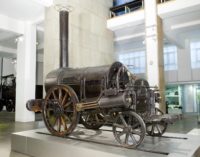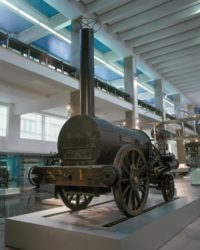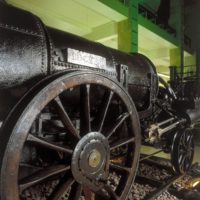 Stephenson’s Rocket, an iconic steam locomotive from the early days of train travel has been laser-scanned in all its 13-feet-long, three-ton glory. It is the largest object in the collection of the Science Museum Group ever to be 3D scanned.
Stephenson’s Rocket, an iconic steam locomotive from the early days of train travel has been laser-scanned in all its 13-feet-long, three-ton glory. It is the largest object in the collection of the Science Museum Group ever to be 3D scanned.
Built in 1829 by Robert Stephenson and Company, Rocket won its manufacturers a lucrative contract with the Liverpool and Manchester Railway when it slaughtered the competition at  the Rainhill Trials on Thursday, October 8th, 1829. It did 70 miles back and forward over a 1.5 mile track with an average running speed of 12 miles per hour and reaching a peak speed of 30 miles per hour. The competition favorite, Novelty, barely moved at all due to multiple joint failures. Sans Pareil was above the weight limit and guzzled fuel at triple Rocket’s rate and ground to a halt when its boiler ran dry.
the Rainhill Trials on Thursday, October 8th, 1829. It did 70 miles back and forward over a 1.5 mile track with an average running speed of 12 miles per hour and reaching a peak speed of 30 miles per hour. The competition favorite, Novelty, barely moved at all due to multiple joint failures. Sans Pareil was above the weight limit and guzzled fuel at triple Rocket’s rate and ground to a halt when its boiler ran dry.
 Robert Stephenson, son of George Stephenson, aka the “Father of the Railways,” worked with his father and other partners to design innovative trains and railways. Rocket incorporated several technological innovations — a single pair of driving wheels, multiple boiler fire-tubes, pistons angled close to horizontal rather than vertical, etc. — which made it faster, more stable and more fuel-efficient than its competitors. These features would be replicated (and improved upon) in future steam locomotives.
Robert Stephenson, son of George Stephenson, aka the “Father of the Railways,” worked with his father and other partners to design innovative trains and railways. Rocket incorporated several technological innovations — a single pair of driving wheels, multiple boiler fire-tubes, pistons angled close to horizontal rather than vertical, etc. — which made it faster, more stable and more fuel-efficient than its competitors. These features would be replicated (and improved upon) in future steam locomotives.
Thanks to the 3D model, Rocket can now be studied in detail from anywhere in the world. Audiences can move this three-tonne locomotive around with ease on screen, peer underneath and explore the innovations which made Rocket the fastest locomotive of its time. […]
Working with Science Museum Group colleagues, a team from ScanLAB spent 11 hours recording every angle of Rocket to create the 3D model using over 200kg of camera, lighting and scanning equipment. Scanning and photography was particularly challenging due to Rocket’s colour, glossy texture and complex shape.
The 3D model was created from 22 high resolution LIDAR scans and 220 gigabytes of photographs (more than 2,500 individual pictures). The ScanLAB team processed the data for six weeks to generate a point cloud of spatial coordinates, color and intensity values for 750 million points. The 3D model is just the beginning. The point cloud information and scans will be set to other uses as well, including an augmented reality environment.
Perhaps a while after Rocket, but, having been a railway freak for the best part of seventy years I only found out this week why the likes of the Stirling eight foot single and Caley 123 lasted so long. Because of the need for synchronisation between cylinders and wheels, the left and right wheels had to be “quartered”, ie set 45 degrees out of true. It was the difficulty of ensuring that all wheels were quartered accurately which was one of the reasons that single driving wheeled locos were preferred for fast passenger train working. There you go, today’s useless fact!
I am currently reading Rhodes “Energy” and just read about this engine a few days ago!
When I was a kid, and hanging around the park by the town walls in Canterbury, UK, while waiting for my parents to finish shopping, I used to wonder at Invicta, a similar and slightly later Stevenson loco designed for the Canterbury-Whitstable. Covered in thick coats of red paint that would go pink, it sat outside on a concrete plinth for decades.
That third picture shows a gravel bed below the rails, unlike the first two. Yet all alt-texts attribute the same museum. What gives?
Felix, I suspect that the smooth-floor and gravel bed shots are because it was at the Science Museum in London, but it has been in the Newcastle Discovery Museum over the summer. So shots from both places?